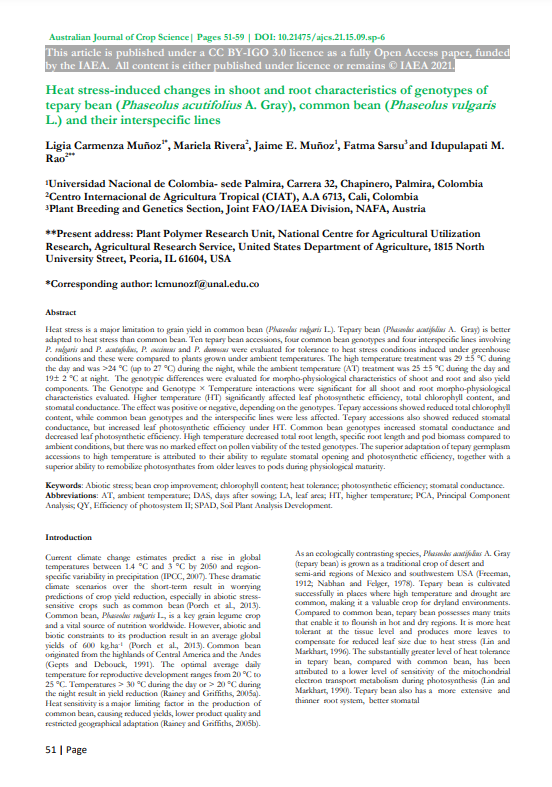Heat stress is a major limitation to grain yield in common bean (Phaseolus vulgaris L.). Tepary bean (Phaseolus acutifolius A. Gray) is better adapted to heat stress than common bean. Ten tepary bean accessions, four common bean genotypes and four interspecific lines involving P. vulgaris and P. acutufolius, P. coccineus and P. dumosus were evaluated for tolerance to heat stress conditions induced under greenhouse conditions and these were compared to plants grown under ambient temperatures. The high temperature treatment was 29 ±5 °C during the day and was >24 °C (up to 27 °C) during the night, while the ambient temperature (AT) treatment was 25 ±5 °C during the day and 19± 2 °C at night. The genotypic differences were evaluated for morphophysiological characteristics of shoot and root and also yield components. The Genotype and Genotype × Temperature interactions were significant for all shoot and root morpho-physiological characteristics evaluated. Higher temperature (HT) significantly affected leaf photosynthetic efficiency, total chlorophyll content, and stomatal conductance. The effect was positive or negative, depending on the genotypes. Tepary accessions showed reduced total chlorophyll content, while common bean genotypes and the interspecific lines were less affected. Tepary accessions also showed reduced stomatal conductance, but increased leaf photosynthetic efficiency under HT. Common bean genotypes increased stomatal conductance and decreased leaf photosynthetic efficiency.
High temperature decreased total root length, specific root length and pod biomass compared to ambient conditions, but there was no marked effect on pollen viability of the tested genotypes. The superior adaptation of tepary germplasm accessions to high temperature is attributed to their ability to regulate stomatal opening and photosynthetic efficiency, together with a superior ability to remobilize photosynthates from older leaves to pods during physiological maturity.
Muñoz, Ligia Carmenza; Rivera, Mariela; Muñoz, Jaime E.; Sarsu, Fatma; Rao, Idupulapati M.

